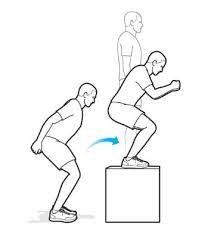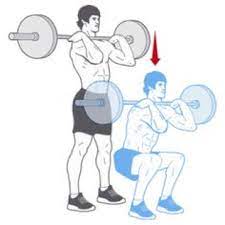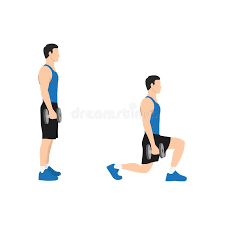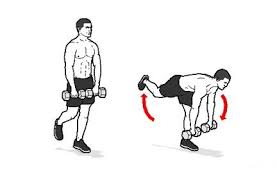1. Overhead Press

Great for: Otherwise known as the military press, the overhead press is a big compound exercise that gives multiple areas of your upper body a thorough workout. Shoulders, triceps, and the trapezius muscles are all activated with this exercise, while core engagement helps with stability and better posture. How to do it: To perform the overhead press: Take the barbell in both hands with palms facing upwards, shoulder-width apart Lift it off the rack so the bar is under your chin, resting on the front of your shoulders, squeezing your shoulder blades together Drive the barbell directly up and over your head, facing forwards as the bar reaches the apex of this motion Lower the bar back down to the starting position, tilting your head back slightly so it can pass your face back to your front shoulders Why: Performed correctly, the overhead press not only develops muscle growth in the aforementioned regions of the upper body it also builds strength in the lower back and spine region. It’s a staple exercise for anyone working on a balanced and healthy upper body which can help create large deltoids. When: Try starting with the overhead press 2-3 times per week, making sure you begin with low weights – mastering the technique is crucial to avoiding potential back injuries
2. Bent-Over Rows
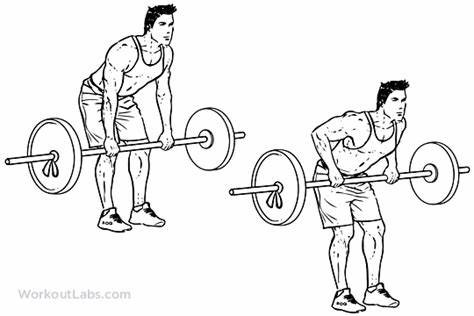
Best Upper Body Exercises - Bent Over Barbell Row Great for: This upper body weight training exercise works out a selection of muscles in the back, including the lats and traps. It’s also an effective method to build core strength and stability, provided you start with low weights to master the form correctly. How to do it: To perform bent-over rows with the correct technique, plate up your barbell, then: Stand with your legs shoulder-width apart, and knees slightly bent. Stick your hips out behind you while bending over at roughly 45-degrees Lift up the barbell with an overhand grip, pulling it up towards your sternum Lower back to the starting position in a controlled motion, making sure your back stays in the same position, so you avoid swinging Why: As well as improving strength and definition in both the upper and lower back, this upper body workout engages the hamstrings and glutes. Shoulder joints also benefit from bent-over rows, making this one of the best upper body exercises you can try. When: Bent-over rows fit in nicely as part of your full-body sessions, so consider including these 2-3 times per week when going for an all-around training session..
3. Bench Press
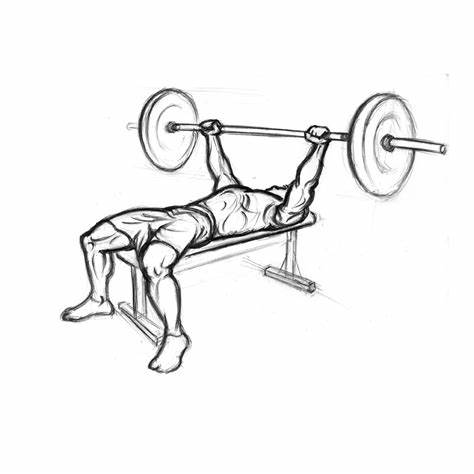
Great for: Another comprehensive exercise for the upper body is the bench press, which is a must if you’re looking to build a great upper body. This classic chest builder also gives your arms a workout while engaging your abs and core as you stabilize the weights. How to do it: Stack the plates on the barbell with it on the bench rack, then: Lie back on the bench with the bar above your head, grabbing it with your palms facing up approximately shoulder-width apart Lift the bar off the rack, bracing your core and using your flat feet to help with balance Slowly lower the barbell down until it lightly touches the middle of your chest Hold for a moment, then push the bar back up to the starting position, contracting and driving the motion with your pectorals Why: The bench press is a chest-focused upper body workout that will build strong, well-defined pecs and can be tweaked to incline or decline presses to further target specific areas of the chest. It also helps with overall upper body endurance, making other exercises such as push-ups easier to perform. When: Depending on how quickly you recover, try including the bench press workout 2-3 times per week as part of an upper-body routine.
4. Push-Ups
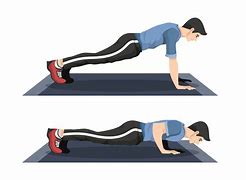
Great for: Push-ups are a great way to build general upper body strength, with an emphasis on the chest muscles. Lower back and core muscles are also engaged with this exercise, helping to strengthen the lower back and reduce the risk of injury. How to do it: To perform push-ups: Get on all fours with hands slightly wider than your shoulders, then extend your feet back and support your weight on your toes Straighten your arms and face the ground, then lower your body down until your chest nearly touches the floor Pause briefly, then push your body back up to the start position Why: Pectorals, triceps, and lats are all activated with push-ups, helping you to develop muscles throughout the upper body region. They also help build a better overall posture and symmetry and improve strength in the elbow and shoulder joints. When: Push-ups can be included 3-4 times per week as part of your upper body gym sessions and full-body workouts, or even included in a warm-up for these days.
5. Pull-Ups
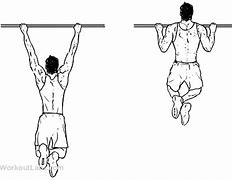
Great for: Pull-ups deliver a range of benefits when performed correctly, including improving overall body strength and fitness and helping with getting a better posture. They also help to improve grip strength and can help you to create a more symmetrical upper body. How to do it: To perform pull-ups: Hang from a pull-up bar with your hands at shoulder-width in an overhand grip Engage your core, then pull your body up until your chin reaches the bar Pause for a second, then lower yourself back to the starting position in a controlled motion Why: Back, shoulders, and arm muscles are all engaged when performing pull-ups, and if you advance to the point where bodyweight doesn’t suffice, you can add additional weights. They also help to develop a stronger grip and improve flexibility in the joints of your shoulders and elbows. When: Feature this workout as part of either your full-body workouts or upper-body sessions, aiming for 2-3 times per week.
6. Tricep Dips
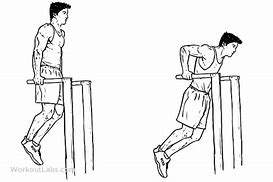
Great for: This bodyweight exercise hits a range of key muscles throughout the upper body, including those in the chest, shoulders, and triceps. It’s ideal if you’re looking for one of the best upper body exercises that helps build overall muscle mass in this region. How to do it: Stand between the parallel dip bars, then: Place your hands on the bars the lift yourself up until your arms are locked Squeeze your glutes and pull in your core, facing forwards as you do so Bend your elbows and lower your body down until your arms are at a 90-degree angle Pause for a moment, then press back up, engaging your hips and core to prevent yourself from swinging and ensuring a smooth ascent Why: Dips can be tweaked so that the majority of your upper body muscles get a workout. Perform them in an upright position, and your triceps will be targeted, but lean over, and you’ll place more emphasis on your chest muscles with each rep. When: With recovery time factored into your schedule, you can perform dips 2-3 times per week as part of an all-round upper body routine or full-body workout.
7. Dumbbell Bicep Curls
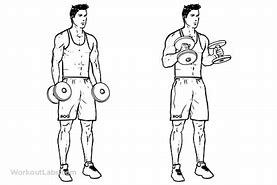
Great for: It should go without saying that this exercise is geared towards building up your biceps, and in this respect, it delivers the goods. Dumbbell bicep curls target both the long head and the short head of the bicep brachii, helping to build great definition in the upper arms. How to do it: Choose the dumbbells of the weight of your choice, then: Stand with your feet shoulder-width apart, holding the dumbbells down at your waist with your palms pointing outwards Engage your core, then lift the weights up at the elbow, keeping these tucked close to your body Lower the weights back down to the starting position Why: As well as hitting various regions of the biceps, dumbbell bicep curls also help develop flexibility in the elbow joints. Grip strength is also improved, especially if you curl the dumbbells inwards towards your body at the peak of the lift. When: This is a staple workout to include 2-3 times per week in your upper body and arm-focused gym sessions.
8. Tricep Extensions
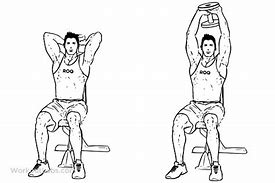
Great for: This exercise can be performed standing or seated and is primarily focused on working the triceps. With variations on the form, you can use tricep extensions to improve strength and muscle growth in your shoulders, lats, and back as well. How to do it: To perform the tricep extension exercise: Stand with your feet shoulder-width apart, holding a dumbbell with both hands Raise the weight directly over your head, holding it on one end of the dumbbell so the other end hangs down. Your palms should be facing upwards and your elbows outwards Squeeze your triceps and engage your core, then bring the weight down behind your head Pause, then lift the weight back up to the starting position Why: A simple but effective exercise, tricep extensions can be used to hit more than just the triceps. Perform this routine from a standing position, and your core will be further engaged, bringing your abs into play as you perform each repetition. When: This is an excellent workout for either upper body or arm-focused gym sessions, which you can include 2-3 times per week.
9. Trap Bar Deadlifts
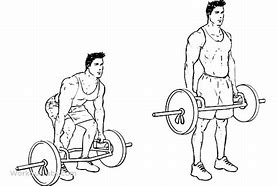
Great for: Trap bar deadlifts help you to build up your glutes, which form the base of support for the rest of your upper body. This exercise is also an effective method for building muscles in your back, bolstering support of your spine. How to do it: To perform the trap bar deadlift, stack the bar with the desired plates, then: Step into the trap bar with your feet at shoulder width Squat down and grab the bars with the palms of your hands facing inwards Bring your hips back and puff your chest out, facing forwards Straight up lifting the bar with your hips and knees, keeping a flat back Squeeze your glutes once the bar reaches the middle of your thigh, then lower the bar back to the floor smoothly Why: This is an easier variation on regular deadlifts, which still manages to impact your quadriceps as well as portions of the upper body. You can also move up to heavier weights with the trap bar deadlift since it reduces the amount of pressure placed on the lumbar spine. When: Include the trap bar deadlift exercise 1-2 times per week as part of a core workout session.
10. Hanging Leg Raises
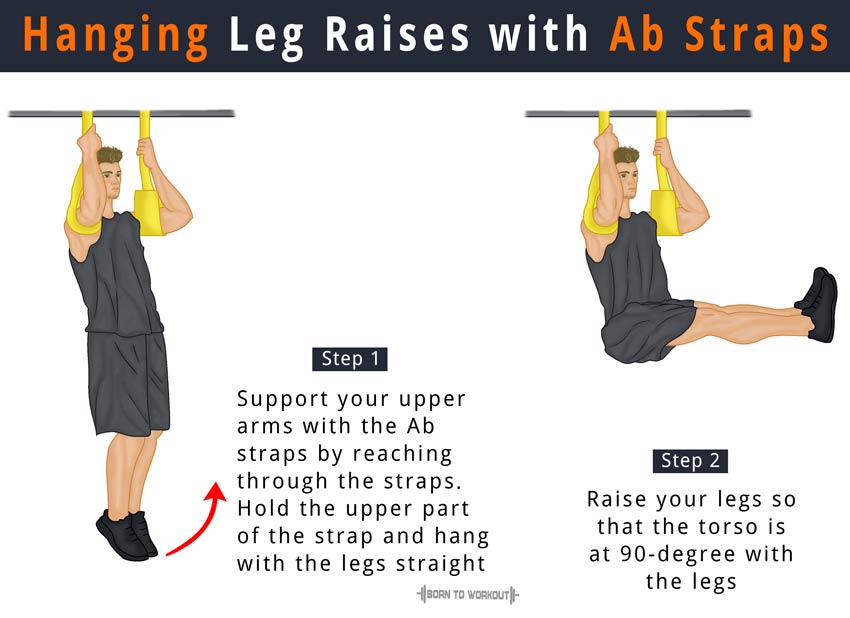
Great for: The free-hanging nature of hanging leg raises makes them an effective way to stretch out your back muscles and spine. This exercise also works the abs and hip flexors, giving your core a solid workout. How to do it: To perform hanging leg raises: Hang from a hanging bar or pull-up bar with your legs completely straight and your hands in an overhand grip shoulder-width apart Raise your legs up and outwards, keeping them straight, aiming to raise them until they are parallel with the floor As you raise your legs, engage your hips and abs to help with the movement Lower your legs slowly back to the starting position Why: This is a great workout for strengthening your grip while also working on your core flexibility. Spine health and overall mobility are also improved by hanging leg raises, building stronger muscles around the base of the spine. When: If you’re new to hanging leg raises, try starting with 5 sets of 5 three times per week, and as you improve, increase the reps or add a weighted belt.
